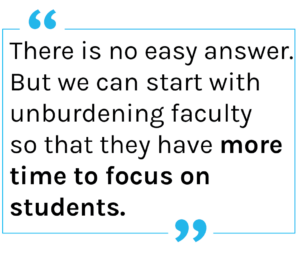Key Takeaways: Driving Student Success Through Course Planning and Academic Effectiveness

In PeopleAdmin’s recent webinar, “Driving Student Success Through Course Planning and Academic Effectiveness,” speakers explored the critical components of ensuring students success within higher education.
Themes included:
- faculty effectiveness,
- the challenges and opportunities of hybrid learning,
- and the pivotal role of data-driven decision-making.
Read on for some key takeaways and check out the full on-demand webinar.
1. What is Academic Effectiveness? Faculty Navigate the Definition
Panelist Andres Taborda, Sales Director for Enflux, noted that a common challenge for faculty is not just achieving academic effectiveness, but defining it in the first place. Is effectiveness measured primarily by pass rates or exam scores? Or is it student engagement and drop-out rates? How do we gauge the curriculum’s impact on these rates, and how do we separate the curriculum from the professor?
Panelist Lucas Del Priore, Product Manager at PeopleAdmin, added that faculty are stretched thin. Even when they have a clear definition of academic effectiveness, they likely don’t have the time or resources to analyze data about program effectiveness.
2. Challenges and Opportunities of the Hybrid Work Model
 The evolving HigherEd landscape includes hybrid work and learning, which brings challenges and opportunities for institutions, students, and faculty. Lucas Del Priore spoke about how hybrid learning has unfortunately led to reduced student engagement, but the hybrid model isn’t going anywhere.
The evolving HigherEd landscape includes hybrid work and learning, which brings challenges and opportunities for institutions, students, and faculty. Lucas Del Priore spoke about how hybrid learning has unfortunately led to reduced student engagement, but the hybrid model isn’t going anywhere.
“There is no easy answer,” says Lucas, “But we can start with unburdening faculty so that they have more time to focus on students.”
To alleviate faculty administrative burden, automation is key. The administrative workload—ranging from reviews to tenure and promotion evaluations—can be substantially reduced through automation, integrations, and digital tools, saving time not just for faculty, but for academic affairs teams.
3. Leveraging Data for Curriculum Effectiveness and Student Success
Andres and Lucas both emphasized the pivotal role of data in enhancing curriculum effectiveness and student outcomes. Having access to course evaluation data enables faculty to reflect on their teaching methods and adjust their curriculum to better align with student needs. The panelists highlighted the need to focus on the right data—looking at the student holistically, rather than just examining passing rates. Timing is also important when it comes to data: it’s more important to know when students are struggling before they fail out, rather than at the end of the course, and real-time data can help.
Final thoughts
The webinar’s key takeaways underscored the power of data-driven insights in understanding both curriculum effectiveness and student success. Enhancing student success requires a multifaceted approach that starts by supporting faculty, embracing data analysis, and promoting collaboration across institutions. When you put these all together, your institution is on the path to achieving its mission.
